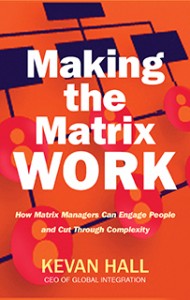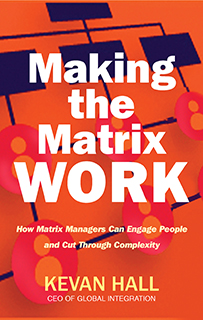
Kevan Hall
More and more of the conversations we are having with Milestone Planner users are about the challenges of matrix working. The formal definition of a matrix is anywhere there are dual reporting lines i.e. people have more than one formal boss. Almost anyone using Milestone Planner will be working on teams where they take instructions from, or are reliant upon, others, either within their own organisation or externally. That means a greater need for matrix management skills, so I was very pleased to have the chance to catch up with Kevan Hall, the author of the new book “Making the Matrix Work.”
What are ‘matrix management’ skills?
Many Milestone Planner users will know – better than most – that work refuses to fit neatly within old-fashioned silos. (As an interesting aside, the matrix structure evolved from the need to manage very complex projects in the aerospace industry in the 1970s.) We need to get things done irrespective of the reporting structure of the people involved. We often need the skills to get things done without having direct control over people and resources needed to deliver results, and have little traditional authority and control fall back on.
 This isn’t always a bad thing. Kevan is the CEO of training consultancy Global Integration, which specialises in matrix management, virtual teams and global working. A recent internal study inside one of the company’s clients showed that employees actually slightly preferred their ‘dotted line’ bosses to their ‘solid line’ bosses, because the dotted line bosses have to try harder to persuade and motivate them to deliver what they want/need.
This isn’t always a bad thing. Kevan is the CEO of training consultancy Global Integration, which specialises in matrix management, virtual teams and global working. A recent internal study inside one of the company’s clients showed that employees actually slightly preferred their ‘dotted line’ bosses to their ‘solid line’ bosses, because the dotted line bosses have to try harder to persuade and motivate them to deliver what they want/need.
We cannot simply focus on activity any more: we need to build long-term relationships and to sustain teams and groups, and that means time and attention needs to be spent on people management as part of any plan.
To add to this, competition for attention is increasing. Global Integration’s benchmarking survey (conducted using SurveyOptic) of over 4,000 people who work in large organisations shows that people are now, on average, a member of five teams. Multiple streams of activity are the norm – another project might simply tip the balance into overload.
However, there is academic evidence that multiple team membership actually leads to an increase in productivity, as people have to become more effective at managing their time. Of course, that is not an unlimited effect – at some point it becomes too much!
These are the kinds of issues addressed in Kevan’s latest book, Making the Matrix Work – how matrix managers engage people and cut through complexity, available from February 7, 2013 – today!). Note: If you work on a team where you think multiple copies may be useful, drop us a line , I’m sure that Global Integration can arrange some discounted copies for your teams.
New ways of working require new ways of thinking, planning and managing. Today’s businesses are very different from those of a few decades ago. It’s time to learn some new skills!

